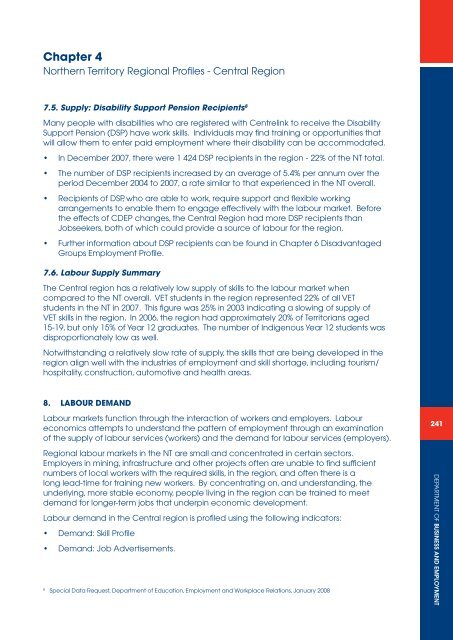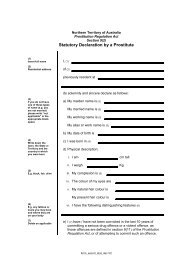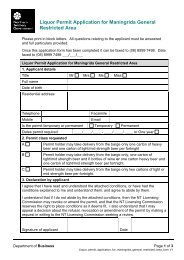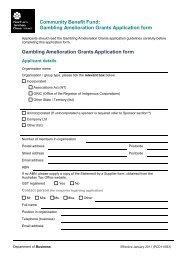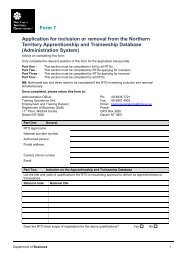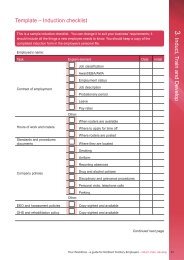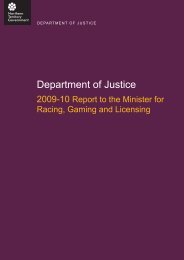Chapter 4 - Department of Business
Chapter 4 - Department of Business
Chapter 4 - Department of Business
You also want an ePaper? Increase the reach of your titles
YUMPU automatically turns print PDFs into web optimized ePapers that Google loves.
<strong>Chapter</strong> 4<br />
Northern Territory Regional Pr<strong>of</strong>i les - Central Region<br />
7.5. Supply: Disability Support Pension Recipients 8<br />
Many people with disabilities who are registered with Centrelink to receive the Disability<br />
Support Pension (DSP) have work skills. Individuals may find training or opportunities that<br />
will allow them to enter paid employment where their disability can be accommodated.<br />
In December 2007, there were 1 424 DSP recipients in the region - 22% <strong>of</strong> the NT total.<br />
The number <strong>of</strong> DSP recipients increased by an average <strong>of</strong> 5.4% per annum over the<br />
period December 2004 to 2007, a rate similar to that experienced in the NT overall.<br />
Recipients <strong>of</strong> DSP, who are able to work, require support and flexible working<br />
arrangements to enable them to engage effectively with the labour market. Before<br />
the effects <strong>of</strong> CDEP changes, the Central Region had more DSP recipients than<br />
Jobseekers, both <strong>of</strong> which could provide a source <strong>of</strong> labour for the region.<br />
Further information about DSP recipients can be found in <strong>Chapter</strong> 6 Disadvantaged<br />
Groups Employment Pr<strong>of</strong>ile.<br />
7.6. Labour Supply Summary<br />
The Central region has a relatively low supply <strong>of</strong> skills to the labour market when<br />
compared to the NT overall. VET students in the region represented 22% <strong>of</strong> all VET<br />
students in the NT in 2007. This figure was 25% in 2003 indicating a slowing <strong>of</strong> supply <strong>of</strong><br />
VET skills in the region. In 2006, the region had approximately 20% <strong>of</strong> Territorians aged<br />
15-19, but only 15% <strong>of</strong> Year 12 graduates. The number <strong>of</strong> Indigenous Year 12 students was<br />
disproportionately low as well.<br />
Notwithstanding a relatively slow rate <strong>of</strong> supply, the skills that are being developed in the<br />
region align well with the industries <strong>of</strong> employment and skill shortage, including tourism/<br />
hospitality, construction, automotive and health areas.<br />
8. LABOUR DEMAND<br />
Labour markets function through the interaction <strong>of</strong> workers and employers. Labour<br />
economics attempts to understand the pattern <strong>of</strong> employment through an examination<br />
<strong>of</strong> the supply <strong>of</strong> labour services (workers) and the demand for labour services (employers).<br />
Regional labour markets in the NT are small and concentrated in certain sectors.<br />
Employers in mining, infrastructure and other projects <strong>of</strong>ten are unable to find sufficient<br />
numbers <strong>of</strong> local workers with the required skills, in the region, and <strong>of</strong>ten there is a<br />
long lead-time for training new workers. By concentrating on, and understanding, the<br />
underlying, more stable economy, people living in the region can be trained to meet<br />
demand for longer-term jobs that underpin economic development.<br />
Labour demand in the Central region is pr<strong>of</strong>iled using the following indicators:<br />
Demand: Skill Pr<strong>of</strong>ile<br />
Demand: Job Advertisements.<br />
8 Special Data Request, <strong>Department</strong> <strong>of</strong> Education, Employment and Workplace Relations, January 2008<br />
241<br />
DEPARTMENT OF BUSINESS AND EMPLOYMENT


